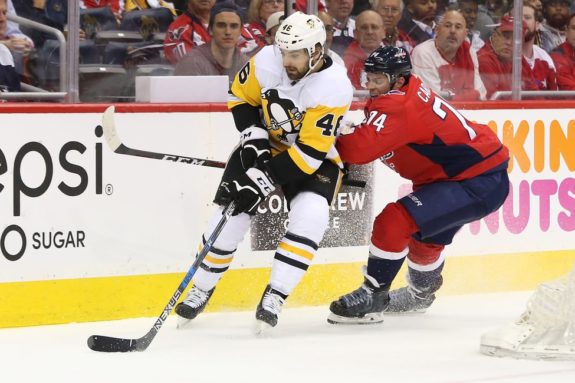Due to a number of factors, the Penguins have been eager to accelerate the development of players from the minors to the pros. Injuries have been a huge factor, and underperforming depth is another. That said, there are multiple prospects who have done relatively well, but left the viewer wanting more.
There has been major success under this model – Conor Sheary, Scott Wilson, Tom Kuhnhackl, Bryan Rust and Jake Guentzel were all contributors to two consecutive Cup runs. Of these, however, only Guentzel seems to have reached his highest possible potential.
More recently, Dominik Simon, Daniel Sprong, and Zach Aston-Reese have all made the big squad, with varying levels of success. All except Sprong were over-agers when they hit the pros. The four youngest forwards still with the franchise are vital to the team’s future, and their development needs to be nurtured.
Jake Guentzel
Guentzel, 24, has been riding shotgun with Sidney Crosby this season, on the same line that saw great success last postseason. Through 12 games last postseason, he had 10 goals and 11 assists. The year prior? He finished with 13 goals, good for second all-time by a rookie behind only Dino Ciccarelli. There’s no doubt that Jake has been supremely integral to the Penguins, and invaluable to their successes.
That said, in 2017-18 he saw a massive dip in points per game from 2016-17 – from the incredible 0.83 to a solid 0.59. He still performed well in terms of advanced stats. He was consistently a positive impact in chances created, but his offensive flow was definitely disrupted for long stretches.

It’s easy to chalk up such a decline to a sophomore slump, but the reasons for his struggles were largely situational. He played lines one, two, and three, and shared the ice with countless linemates. It was difficult for him to find chemistry when he could never anticipate who it was he would be playing with.
When he actually played on the power play, Jake was at his best. Deployed in the high or low slot, Guentzel was deadly with a quick, accurate release and soft hands that deflected wristed point shots. He certainly recovered his scoring touch at even strength in the playoffs, but it was a bumpy road getting there.
Dominik Simon
Breaking into the league at the age of 21 as a fifth-round selection is unusual. His brief roster insertions were a reward for playing solid two-way hockey in Wilkes-Barre, and considering he only played five games until 2017-18, it didn’t derail his progression.
At the age of 23, Simon stuck for 33 games last season. He scored four goals and added eight assists in that time, but, more importantly, he was a possession beast. He helped the defensive play of Crosby’s line immensely when he was slotted there. Those two-way qualities have endeared him to Mike Sullivan, who has praised his ability to contribute all over the lineup.

While his versatility is an immense asset, Simon is another player who has been shuffled a lot. He was part of the constant rearranging of the bottom-six last season, which seemed to hurt him in terms of offense. Simon has shown skill in burying the biscuit, but that has never been fostered in Pittsburgh.
He scored 18 goals in 50 games at the age of 21 in the Czech League for HC Plzen, and 25 goals in 68 games his first year as a pro in Wilkes Barre. From there, his offensive totals have only declined. I fear Simon may be on a similar path as Kuhnhackl, who was pegged exclusively as a defensive specialist due to his usage. Others, such as those at Pensburgh, believe he’s due for a breakout. Only time will tell, and I hope that Simon can start finding his finish once again.
Daniel Sprong
No player in the organization is more divisive at the moment than Daniel. He has been projected by some to score 30 goals, and by others to be relegated to trade bait by the new year. Considering his current placement on the fourth line, I fear for his longevity in Western Pennsylvania.
Rutherford has been a supporter of his in the organization and was a big reason he made the club as an 18-year-old in Mike Johnston’s partial and final season as coach. Last spring, the opinion of him internally shifted dramatically toward the negative.
Throughout his AHL All-Star dominant performance in 2017-18, articles from the team questioned his play in the neutral and defensive zones. Although he will never win a Selke, I don’t see the same glaring issues that the coaching staff in Wilkes Barre and Pittsburgh do.

The problems for Daniel arguably began from the start, when he played for a sub-par coach as a very raw talent out of Charlottetown in 2015-16. It takes not only exceptional talent, but an abnormally mature game to make the leap to the NHL as a teenager. He earned a spot, but the decision to insert him into a lineup and only give him single digit minutes of ice-time was seriously detrimental to his confidence.
Almost every decision since then has seemingly undermined his swagger and offensive mindset. Sprong was drafted to be a dynamic, goal-scoring winger, but at this point, he’s simply trying his best to conform to the game Sullivan and others have demanded he play.
Oddly enough, he’s still a decent possession player, and potted two assists in three games thus far. Developmentally, I fear for this situation. At 21-years-old, he’s too great an asset to the Penguins to continue jeopardizing his growth through misuse.
Zach Aston-Reese
Zach Aston-Reese is the one prospect of the four who has been handled with total patience. Aston-Reese dominated Northeastern University in his senior year and aided the Wilkes Barre team with a productive post-season in 2016-17. He was given a chance to make the team out of camp but needed to pack on some weight and muscle in a full season in the AHL.
Watching him multiple times first-hand, his ability to adjust to the pros at a rapid rate was truly impressive. He’s a smart player, built in the mold of a Zach Parise – awareness in and around the opposition net. He eliminated any risky passing and started bulking up. Whereas he was being obliterated by checks in corners in September, he was winning battles with consistency in December.
The Penguins were definitely tempted to call him up to help negate injury and lackluster play. Thankfully, they didn’t pull the trigger until February. By then he was over 205 pounds and confident.

Unfortunately for Zach, he started his offseason early after being injured in the second round of the playoffs. Instead of rushing him back into the bottom-six in Pittsburgh, the organization wisely decided to send him back for some conditioning in Wilkes Barre to begin 2018-19. He won their first game in a shootout, and looked very impressive throughout. Allowing this player to dominate for a bit will only improve his odds of being an offensive success – both this spring and for many years going forward.
Ultimately, the Penguins are an aging team. Crosby, Malkin, Kessel, and Letang are all over 30-years-old. In a league that has increasingly valued youth and cheap contracts, there is strong allurement to thrusting players into situations they just aren’t ready for. Guentzel seems to have found his way through the labyrinth, but it shouldn’t be assumed that all our young players will.
Managing the team’s youth carefully is crucial going forward, after trading away multiple draft picks for recent playoff success. Pittsburgh simply can’t afford to mishandle development of these potential gems, so it falls on the coaching staff to find comfortable roles for them all. As of now, the jury is still out.